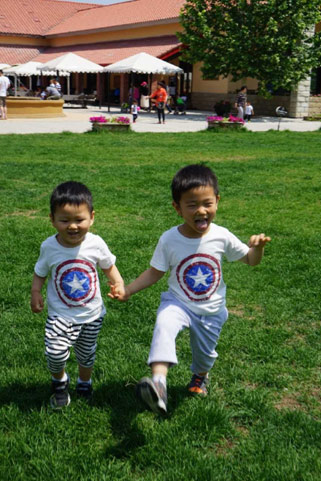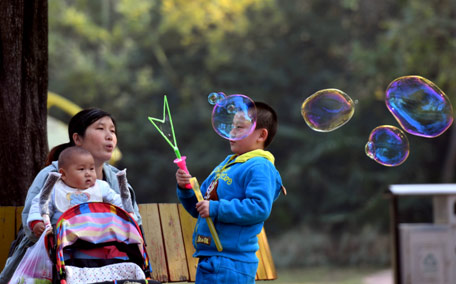

 |
| As the implementation of the comprehensive two-child policy, there are more two-child families in China. Pictured are two brothers having fun at a farm in Beijing’s suburb. (Photo by Meng Xianglin from People’s Daily) |
Nearly Half of the total Newborn Population are not First Child in Chinese Families
China’s newborn population reached the highest level since 2000 in 2016, the first year of the implementation of the comprehensive two-child policy and the third year of the previous partial two-child policy, data released by relevant Chinese authorities showed, proving that the two-child policy has shown apparent effects.
After a 1‰ sampling survey, the National Bureau of Statistics of China estimated that the new-born population in 2016 amounted to 17.86 million. Statistics from China’s National Health and Family Planning Commission (NHFPC) revealed that in 2016, more than 18.46 million infants were delivered in hospitals nationwide.
The adjustment and improvement of China’s birth policy has driven a significant increase in second child. The previous partial two-child policy only allowed couples to have two children if one of them was an only child.
Before 2013, the second children usually accounted for 30 percent of the total newborn population every year. Between 2015 and 2016, that percentage was over 45 percent, a double-digit growth in percentage points.
Statistic showed that from 2011 to 2015, the number of women of childbearing age dropped by approximately 3.5 million each year. It is predicted that from 2016 to 2020, the number will fall by 5 million annually. However, due to the improvement of the two-child policy, China’s newborn population still maintains a growing trend.
Yet, there is still a gap between relevant supporting social and economic policies and the general public’s willingness to actually give birth to a second child, which requires further measures.
A large-scale survey on people’s willingness to give birth conducted by the NHFPC in 2015 found that 74.5 percent of the families would not raise a second child due to economic reasons, another 61.1 percent would not due to the efforts involved in child-raising while another 60.5 percent would not due to lack of caretakers. Parenthood pressure, raising cost, women’s career development, pursuit of life quality and other factors now pose more limitations on the Chinese people’s willingness to have a second child.
Another survey showed that childcare cost occupies nearly half of the average income of Chinese households, among which education occupies a significant part.
Childcare service is now in severe shortage. Only 4 percent of infants aged between 0 to 3 years old in China receive childcare service from various agencies, far below the 50 percent ratio of some developed countries.
More than 40 departments under the State Council have been assigned specific duties to roll out supporting policies and a birth-friendly social environment so as to encourage people to give birth to a second child.
 |
| On November 3, 2016, two children and their mother are playing at Bishagang Park in Zhengzhou, Central China’s Henan Province. (Photo by People’s Daily) |
 Fire brigade in Shanghai holds group wedding
Fire brigade in Shanghai holds group wedding Tourists enjoy ice sculptures in Datan Town, north China
Tourists enjoy ice sculptures in Datan Town, north China Sunset scenery of Dayan Pagoda in Xi'an
Sunset scenery of Dayan Pagoda in Xi'an Tourists have fun at scenic spot in Nanlong Town, NW China
Tourists have fun at scenic spot in Nanlong Town, NW China Harbin attracts tourists by making best use of ice in winter
Harbin attracts tourists by making best use of ice in winter In pics: FIS Alpine Ski Women's World Cup Slalom
In pics: FIS Alpine Ski Women's World Cup Slalom Black-necked cranes rest at reservoir in Lhunzhub County, Lhasa
Black-necked cranes rest at reservoir in Lhunzhub County, Lhasa China's FAST telescope will be available to foreign scientists in April
China's FAST telescope will be available to foreign scientists in April "She power" plays indispensable role in poverty alleviation
"She power" plays indispensable role in poverty alleviation Top 10 world news events of People's Daily in 2020
Top 10 world news events of People's Daily in 2020 Top 10 China news events of People's Daily in 2020
Top 10 China news events of People's Daily in 2020 Top 10 media buzzwords of 2020
Top 10 media buzzwords of 2020 Year-ender:10 major tourism stories of 2020
Year-ender:10 major tourism stories of 2020 No interference in Venezuelan issues
No interference in Venezuelan issues
 Biz prepares for trade spat
Biz prepares for trade spat
 Broadcasting Continent
Broadcasting Continent Australia wins Chinese CEOs as US loses
Australia wins Chinese CEOs as US loses